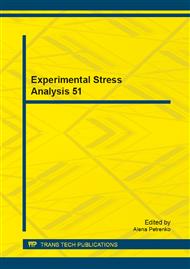[1]
G.T. Huang, Pulp and dentin tissue engineering and regeneration: current progress, Regen. Med. 4 (2009) 697-707.
Google Scholar
[2]
S.D. Heintze, G. Zappini, V. Rousson, Wear of ten dental restorative materials in five wear simulators—Results of a round robin test, Dent. Mat. 21 (2005) 304-317.
DOI: 10.1016/j.dental.2004.05.003
Google Scholar
[3]
Z.R. Zhou, J. Zheng, Tribology of dental materials: a review, J. Phys. D: Appl. Phys. 41 (2008) 113001.
Google Scholar
[4]
N.P. Suh, Tribophysics, Prentice-Hall, Englewood Cliffs, NJ, (1986).
Google Scholar
[5]
J.D. Currey, Bones: Structure and Mechanics, Princeton University Press, Princeton, 2002, p.436.
Google Scholar
[6]
G. Guidoni, M. Swain, I. Jäger, Enamel: From brittle to ductile like tribological response, J. Dent. 36 (2008) 786-794.
DOI: 10.1016/j.jdent.2008.05.011
Google Scholar
[7]
S. Habelitz, S.J. Marshall, G.W. Marshall, M. Balooch, Mechanical properties of human dental enamel on the nanometre scale, Arch. Oral. Biol. 46 (2001) 173-83.
DOI: 10.1016/s0003-9969(00)00089-3
Google Scholar
[8]
I.D. Spary, A.J. Bushby, N.M. Jennett, On the indentation size effect in spherical indentation, Philos. Mag. 86 (2006) 5581-5593.
DOI: 10.1080/14786430600854988
Google Scholar
[9]
S. Palaniappan, J.P. Celis, B. Van Merbeek, M. Peumans, P. Lambrechts, Correlating in vitro scratch test with in vivo contact free occlusal area wear of contemporary dental composites, Dent. Mater. 29 (2013) 259-268.
DOI: 10.1016/j.dental.2012.10.007
Google Scholar
[10]
J.S. Field, M.V. Swain, A simple predictive model for spherical indentation, J. Mater. Res. 8 (1993) 297-306.
DOI: 10.1557/jmr.1993.0297
Google Scholar
[11]
W.C. Oliver, G.M. Pharr, An improved technique for determining hardness and elastic modulus using load and displacement sensing indentation experiments, J. Mater. Res. 7 (1992).
DOI: 10.1557/jmr.1992.1564
Google Scholar
[12]
V. Jardret, H. Zahouani, J.L. Loubet, T.G. Mathia, Understanding and quantification of elastic and plastic deformation during a scratch test, Wear 218 (1998) 8-14.
DOI: 10.1016/s0043-1648(98)00200-2
Google Scholar
[13]
L.H. He, N. Fujisawa, M.V. Swain, Elastic modulus and stress–strain response of human enamel by nano-indentation, ISRN Biomaterials 27 (2006) 4388-4398.
DOI: 10.1016/j.biomaterials.2006.03.045
Google Scholar
[14]
J.F. Archard, Contact and Rubbing of Flat Surfaces, J. Appl. Phys. 24 (1953) 981-988.
Google Scholar
[15]
A. Leyland, A. Matthews, On the significance of the H/E ratio in wear control: A nanocomposite approach to optimised tribological behavior, Wear 246 (2000) 1-11.
DOI: 10.1016/s0043-1648(00)00488-9
Google Scholar
[16]
B.D. Beake, T.W. Liskiewicz, Comparison of nano-f`retting and nano-scratch tests on biomedical materials, Tribol. Int. 63 (2013) 123-131.
DOI: 10.1016/j.triboint.2012.08.007
Google Scholar


